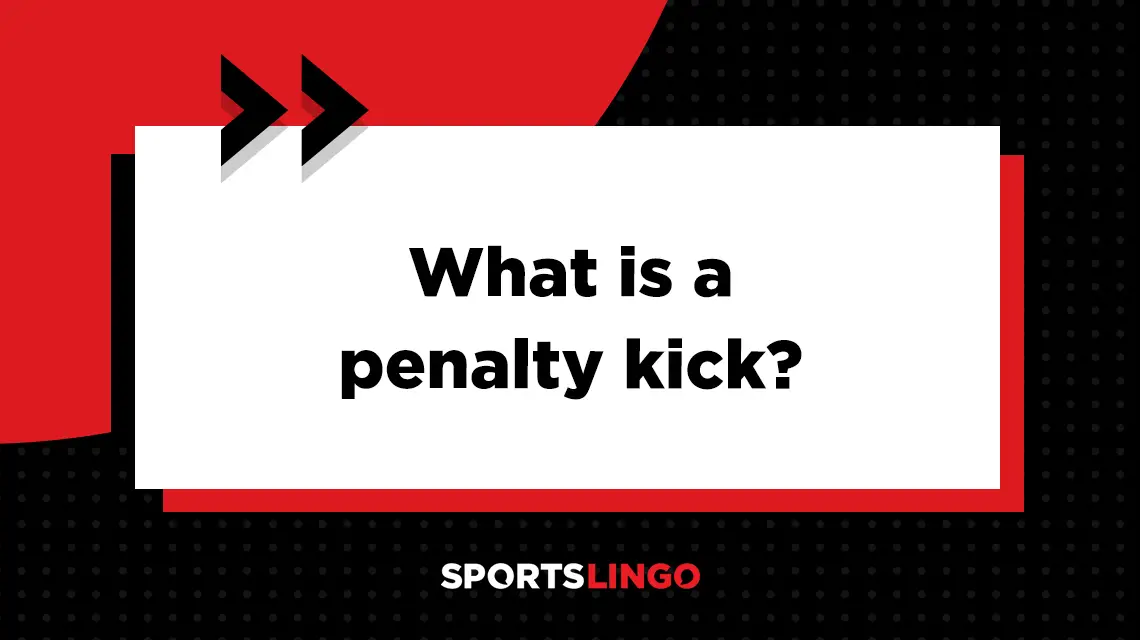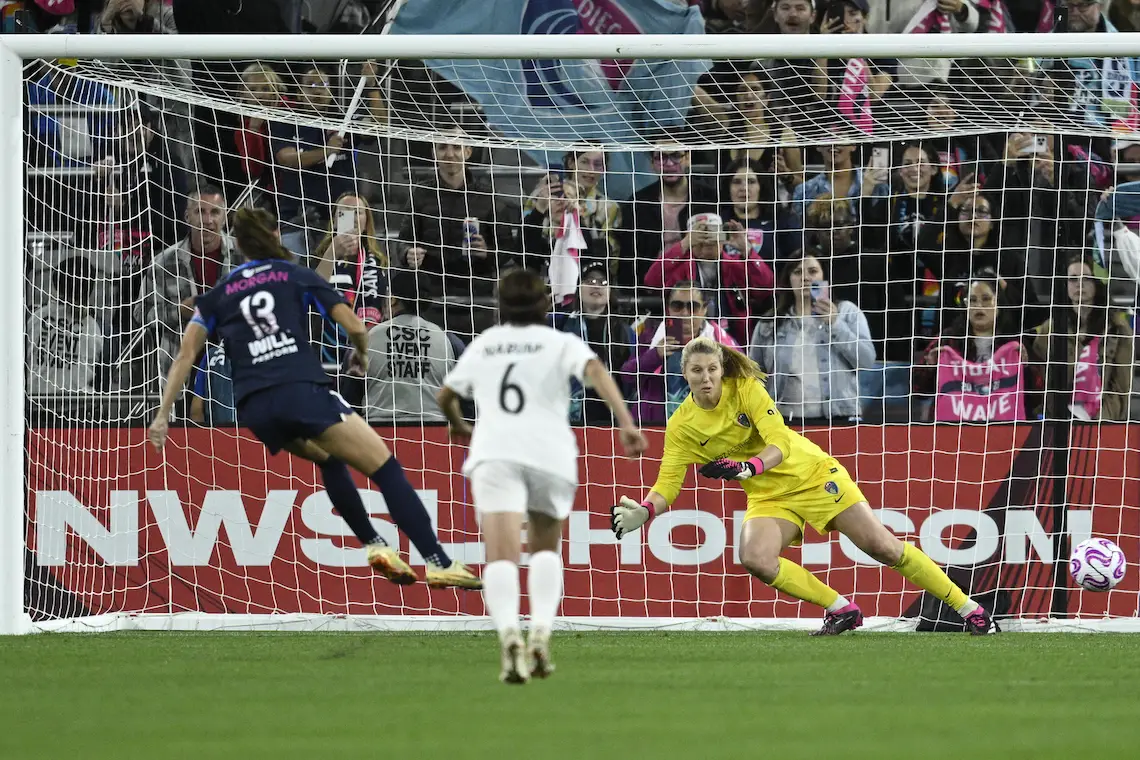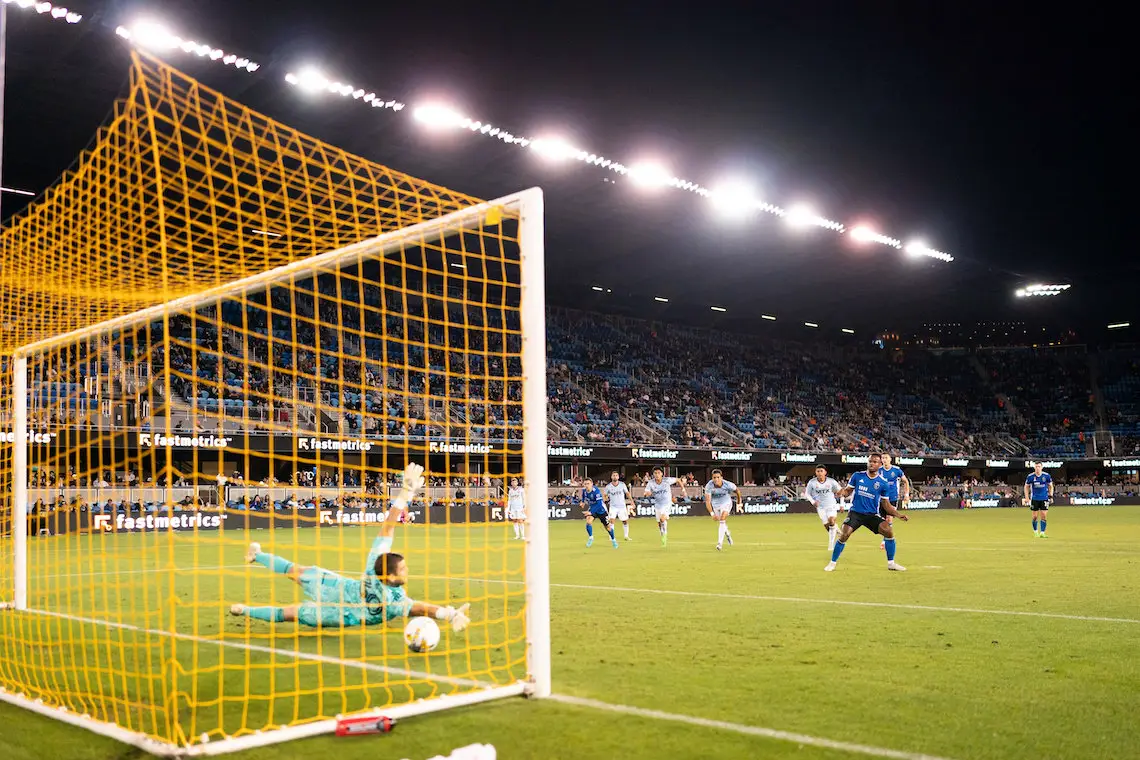
pen*al*ty kick
What is the definition of penalty kick in soccer?
1. A penalty kick is a kick that is taken only 12 yards away from the goal line. The penalty kick is awarded to an offensive player after the defensive team has committed a foul within its own penalty area, which usually results in a direct free kick.
What is a penalty kick?
A penalty kick is a type of direct free kick in soccer that happens when a player commits a foul inside their own penalty area. The kick is taken from the penalty spot, which is 12 yards away from the goal line.
Only the goalkeeper can defend the goal during a penalty kick. Meanwhile, the other players must stay outside the penalty area. The player taking the penalty kick tries to score a goal by kicking the ball past the goalkeeper into the net.
Penalty kicks are exciting moments in soccer games and can sometimes decide the outcome of the match.
What is the difference between a free kick and a penalty kick?
A free kick is awarded when the opposing team commits a foul outside the penalty area. In contrast, a penalty kick is awarded for a foul committed inside the penalty area.
During a free kick, all players can be in the penalty area, while during a penalty kick, only the goalkeeper can defend the goal. Additionally, penalty kicks are taken from a designated spot 12 yards away from the goal line, while free kicks can be taken from anywhere on the field.
Is it a penalty kick or penalty shot?
The correct terminology is “penalty kick”. However, the term “penalty shot” is still sometimes used to describe a penalty kick in soccer.
Why is a penalty kick made?
A penalty kick gives a team a chance to score a goal after an opposing player commits a foul inside the penalty area. It is a way to punish the opposing team for breaking the rules and provide a fair opportunity for the other team to score.
Penalty kicks are usually taken when the player who was fouled is prevented from having an honest chance to score a goal, so the penalty kick gives them a second chance to make up for it.

Kelvin Kuo/USA TODAY Sports
What are some reasons why a penalty kick is awarded?
A penalty kick is awarded when a defending player commits a foul inside their penalty area, preventing an attacking player from scoring a goal.
Some examples of fouls that result in a penalty kick are:
- Tripping or pushing an opponent
- Holding or grabbing an opponent
- A handball inside the penalty area
- A reckless tackle that endangers the safety of an opponent
These fouls are considered severe enough to warrant a penalty kick as a punishment. The penalty kick provides a way to give the attacking team a fair chance to score a goal.
What is a hand ball penalty in soccer?
A hand ball penalty occurs when a player handles the ball intentionally or unintentionally with their hand or arm, which typically results in an indirect free kick for the opposing team. This type of foul does not result in a penalty kick unless it happens inside the defending team’s penalty area.
Who takes the penalty kick?
The player who was fouled is usually the player who takes the penalty kick. Sometimes, the team’s regular penalty taker designated by the coach takes the kick if they are on the field.
Can the defending team make substitutions before a penalty kick is taken?
The defending team can make substitutions before a penalty kick is taken as long as they follow the standard substitution rules. The goalie can also be substituted for a player who is considered a better penalty stopper. However, once the referee has signaled for the penalty kick, no more substitutions can be made by either team.
How is the penalty kick taken?
During a penalty kick, the ball is placed on the penalty spot, and the kicker takes a few steps back before running toward the ball and kicking it. The kicker’s teammates must stay outside the penalty area, and only the opposing team’s goalkeeper can defend the goal. The kicker aims to score a goal by kicking the ball past the keeper and into the net.
What are the rules of a penalty kick?
According to Law 14 of the International Football Association Board’s (IFAB) Laws of the Game, the basic rules of a penalty kick in soccer are:
- The ball must be placed on the penalty spot.
- The player taking the penalty kick must be clearly identified.
- Only the goalkeeper can defend the goal and must have at least part of one foot behind or touching the goal line.
- All players besides the kicker and the keeper must stay outside the penalty area.
- The kicker must wait for the referee’s signal before taking the kick.
- The ball must be kicked forward.
- The kicker may not touch the ball a second time until it has been touched by another player.
- If the ball hits the post or crossbar and goes into the goal, it’s still a goal.
- The penalty kick is completed when the ball stops moving, goes out of play or the referee stops play for any offense.
How far away is the penalty spot from the goal line?
The penalty spot, also known as the penalty mark, is 12 yards away from the goal line in soccer.
How much time does a player have to take a penalty kick?
Once the referee signals for the penalty kick, the player taking the kick has a few seconds to make the attempt. There is no set time limit.
What happens if the goalkeeper moves before the kick is taken?
If the goalkeeper moves off the goal line before the kick is taken, the referee can choose to order a retake of the penalty kick.
How many penalty kicks are allowed?
The number of penalty kicks awarded in a game depends on the number of fouls the defending team commits inside their own penalty area.
What happens if the ball hits the post or crossbar?
If the ball hits the post or crossbar and bounces back into play without crossing the goal line, the penalty kick is considered unsuccessful. However, if it hits the goalpost and goes into the goal, it’s still a goal.
Can you feint on a soccer penalty kick?
Feinting, or pretending to take a penalty kick but stopping before striking the ball, is allowed during the run-up but not after. If a kicker feints after the run-up, the referee may give them a yellow card for unsporting behavior.
What is the penalty for a missed penalty kick?
There is no penalty for a missed penalty kick, but the team loses the chance to score a goal and the opposing team gains possession of the ball.
What is the possible score for a penalty kick?
A successful penalty kick results in one goal scored for the team who made the kick.
How often are penalty kicks awarded?
The frequency of penalty kicks awarded varies from game to game. It depends on how many fouls the defending team commits inside the penalty area.
In an analysis of one season of Premier League soccer, penalty kicks were found to be awarded in about 1 out of 5 matches.
How often are penalty kicks successful?
Penalty kicks are generally successful and have a high scoring rate of around 75% to 85%. However, there is no guarantee that a penalty kick will be successful as it depends on various factors, including the skills of the goalie and the kicker.
Do all soccer penalties result in penalty kicks?
Only soccer penalties that occur inside the penalty area of the defending team result in penalty kicks.
What is a goal kick?
A goal kick is a type of soccer restart awarded to the defending team when the attacking team kicks the ball out of bounds over the goal line. Unlike a penalty kick, a goal kick is not awarded due to a foul, and the defending team’s goalkeeper usually takes it.
What is a corner kick?
A corner kick is a type of free kick taken from the corner of the field. It is awarded when the defending team kicks the ball out of bounds and it passes over the goal line. Unlike penalty kicks, corner kicks are not granted due to a foul.
What is the penalty for a red card?
A red card in soccer is given to a player who commits a serious foul or receives two yellow cards in a match. The player must leave the field, and their team is forced to play with one less player for the rest of the game. If a player commits a serious offense warranting a red card in their penalty area, the opposing team may be awarded a penalty kick.

Stan Szeto/USA TODAY Sports
What is a penalty shootout?
A penalty shootout is a way of determining the winner of a soccer match that is tied after extra time in a knockout competition.
Each team selects five players to take penalty kicks against the opposing team’s goalkeeper, and the team that scores the most goals wins.
If the score is still tied after the first five kicks, the shootout continues with one additional kick for each team until a winner is determined.
Are there any special rules for penalty kicks during a penalty shootout?
During a penalty shootout, specific rules apply to taking penalty kicks. These rules are outlined in Law 10 of the Laws of the Game and include:
- The team that wins the coin toss decides whether to take the first or second kick.
- Only players on the field or temporarily off the field are eligible to take kicks.
- Each team selects the order in which they will take the kicks.
- If one team has more players than its opponents, it must reduce its numbers to match.
- A different player takes each kick, and all eligible players must take one before any player can take a second.
- The team with the most goals after five kicks wins the match.
- If the score is tied after five kicks, the shootout continues until one team scores more goals.
Do penalty kicks require skill?
Penalty kicks require skill, as the kicker must be able to accurately and powerfully strike the ball while also outsmarting the goalie. The ability to stay calm under pressure is also crucial for success.
What are some strategies for taking a penalty kick?
To successfully complete a penalty kick, a player should choose a spot to aim, kick the ball with power and attempt to get it past the goalkeeper by shooting to their weaker side. They should try to stay calm and focused and may also use a feint in the run-up to deceive the goalie.
What are some noteworthy penalty kicks in professional soccer history?
Penalty kicks in professional soccer can be some of the most memorable moments in the sport. From game-winning strikes to heartbreaking misses, here are a few noteworthy penalty kicks that have left their mark on the game.
Andrea Pirlo’s Panenka penalty in Euro 2012
Andrea Pirlo’s penalty kick in the Euro 2012 quarterfinals pitting Italy against England was a masterpiece. He chipped the ball over the diving goalkeeper with a cheeky and audacious Panenka penalty. The goal helped Italy win the game, and Pirlo’s skillful penalty kick is still remembered today as one of the most outstanding penalty kicks ever.
Lionel Messi’s shootout miss in the 2016 Copa America Final
In the 2016 Copa America final between Argentina and Chile, Lionel Messi missed a crucial penalty kick in the shootout, leading to Argentina losing the final. Messi famously announced his retirement from international football soon after, shocking soccer fans worldwide.
Manchester United vs. Chelsea in the Champions League Final 2008
Manchester United and Chelsea had an epic penalty shootout in the 2008 Champions League final. Cristiano Ronaldo missed his penalty, and John Terry slipped while taking his, giving Man United new hope. But, in the end, Nicolas Anelka’s penalty was saved, and Manchester United won their third European Cup.
Ghana vs. Uruguay in the 2010 FIFA World Cup Quarterfinal
In the 2010 World Cup quarterfinal, Asamoah Gyan had a chance to send Ghana through to the semifinals after Luis Suarez famously used his hands to prevent Ghana from scoring, resulting in a red card. But instead, he hit the crossbar with his penalty kick, allowing Uruguay to advance anyways.
Which team is the best at penalty kicks?
It’s difficult to determine which team is the best at penalty kicks since it depends on various factors, such as the skill of the current players and the opposing team’s goalkeeper. However, some teams, like Argentina and Germany, have a reputation for being successful in penalty shootouts.
Who is the best penalty taker of all time?
There is much debate over who the best penalty taker of all time is, as it’s subjective and depends on personal opinion. However, players like Matt Le Tissier, Lionel Messi and Cristiano Ronaldo are considered among the best.
Who invented penalty kicks in soccer?
Penalty kicks were invented by Irish goalkeeper William McCrum in 1890 and adopted by the International Football Association Board in 1891. The IFAB is responsible for making changes and amendments to the laws of soccer.
Example of how penalty kick is used in commentary
1. While dribbling the ball up the field on a breakaway, the Kroos gets pulled down from behind after he crosses into the penalty area and is then awarded a penalty kick due to the foul by the defender.
Sport the term is used
1. Soccer
Abbreviated as:
1. PK